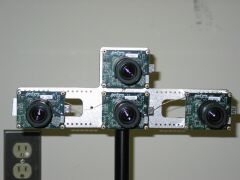 Tele-Immersion
Tele-Immersion
The Tele-immersion Project at Penn has built a 60 camera cluster using IEEE 1394 cameras. Much of the system was built using off the shelf products. A few of the mounting hardware had to be custom made in the workshop.
Each camera is a Pointgrey Research's Dragonfly 640x480. The three black and white cameras are responsive in the Infra Red Spectrum (CCD:ICX084AL). They do not have a filter for blocking IR. The color camera however blocks IR as it has a IR block filter. The Dragonfly cameras have the external trigger capability. Each camera is always synchronized to the other cameras on the same bus. However this application needs that all cameras should grab images simultaneously and remain synchronized. This was achieved using external trigger and the Point Grey Research Sync Units. Each camera unit is connected to a Dell Precision 530 Workstation (dual 2.4 Ghz Pentium 4 with an integrated 1394 controlller). The cameras can all be calibrated together. These cameras are used for acquiring the entire room in 3D. It can also be used to capture image data sets to disk.All the machines are connected to a gigabit switch which provides connnection to Abilene. The machines are dual boot with Linux and Windows 2000. The streaming video server runs under Linux. More details on the actual software architecture will be made available soon.
The camera units are mounted on a 80/20 Aluminium Frame which is attached to a truss. The lighting for this setup is provided by fluorescent lights from Brightlines. To have more structure in the room we use invisible structured light using five modified Kodak Ektagrpahic projectors which can be mounted on top of the truss.

Figure 1
The four camera unit with the color camera on top and three BW cameras in the bottom row

Figure 2
The truss and the 80/20 frame used to hold the cameras

Figure 3
The machines
Home | People | Research | Publications | Multimedia | Download | Contact Us
GRASP Lab, University of Pennsylvania, Philadelphia, PA 19104
Site Managed by Nikhil Kelshikar
Last Updated on 12/12/2002.